Porsche 911 (964) – The Story
The Type 964 Represented One of the Most Significant Steps Forward for Porsche
Type: 964
Generation: Third Generation 911
Manufacturer: Porsche AG
Production Years: 1989 - 1993
Model Years: 1989 - 1994
Designer: Benjamin Dimson
Body Style: 2-Door Coupe, 2-Door Roadster, 2-Door Targa
Layout: Rear-engine, rear-wheel drive, Rear-engine, all-wheel drive
Engines: 3.3 L M30/69 turbo flat-6, 3.6 L M64/01, 02, 03, 3.6 L M64/50 turbo, 3.75 L M64/04 (3.8 RS/RSR)
Transmission: 4-spd auto, 5-spd manual
Production: 63,762 units
Premiere: 1988 September 28 at Mondial de l'Automobile, Paris
Predecessor: G-Series
Successor: Porsche 993
964 Maintenance
964 Buyers Guide (Coming Soon)
Few cars in automotive history have managed to walk the tightrope between tradition and innovation quite like the Porsche 911. By the late 1980s, the 911 had already become a motoring icon—an unmistakable silhouette, a rear-mounted flat-six soundtrack, and a driving experience like no other. But it was also a car under pressure. Emissions regulations, crash standards, and the demands of modern consumers were closing in. Many within Porsche thought the end of the classic 911 era was near. Instead, in 1989, Porsche unveiled the 964 generation—a car that looked familiar on the surface, yet beneath its curvaceous skin lay one of the most comprehensive redesigns in 911 history.
Codenamed 964 internally, this fourth generation of the 911 was introduced as the Carrera 4 in late 1988, followed by the rear-wheel-drive Carrera 2 in 1989. Porsche claimed that 85% of the 964’s components were new, even though to the untrained eye it appeared to be just another subtle evolution of the long-loved 911 shape. The company wanted to reassure purists that it hadn’t abandoned the 911’s soul—but make no mistake, this was an all-new car for a new decade.
The first and most dramatic change was mechanical: the 964 Carrera 4 became the first production 911 to feature all-wheel drive. Derived from the system used in the 959 supercar, the 964’s AWD setup offered variable torque distribution and instantly transformed the 911’s handling reputation from tail-happy unpredictability to a far more stable, confidence-inspiring experience. It was a bold move, signaling Porsche’s intention to blend its racing pedigree with modern performance technology.
But the innovations didn’t stop there. The 964 introduced power steering and ABS brakes for the first time in a 911—two features purists initially viewed as heresy, but ones that proved essential for taming the growing performance of the car. Its new coil-spring suspension replaced the old torsion bars, marking a major leap in ride quality and adjustability. The aerodynamics were also significantly improved, thanks to a smoother front bumper design and a retractable rear spoiler that rose automatically at speed. It was a subtle but significant step toward the more integrated styling of later 911s.
At the heart of every 964 sat a 3.6-liter air-cooled flat-six, internally designated M64. It produced 250 horsepower and 228 lb-ft of torque, up from the outgoing 3.2 Carrera’s 217 hp. This new engine featured dual-spark ignition, a modernized intake and exhaust system, and improved oil cooling. The result was smoother power delivery and a broader torque curve—traits that made the car not only faster (0-60 mph in around 5.5 seconds for the Carrera 2 manual) but also more usable day-to-day. The engine retained Porsche’s legendary reliability when properly maintained, but its more sophisticated systems meant owners now had to deal with a new level of complexity—an early glimpse into the challenges that would define modern Porsche ownership.
The 964 was more refined than any 911 before it, but it didn’t sacrifice engagement. The steering—now hydraulically assisted—retained its trademark feel and precision. The updated suspension offered both comfort and composure. For the first time, the 911 felt genuinely comfortable as a grand tourer, while still delivering the raw, rear-engine thrills enthusiasts expected.
Inside, the 964 marked the last 911 generation to retain the classic upright dashboard design that had its roots in the 1960s. Yet ergonomics were vastly improved, with better air conditioning, modern switchgear, and more comfortable seats. It managed to feel both vintage and contemporary—a delicate balance that has only grown more charming with time.
The 964 generation was far from static. Over its short five-year lifespan, Porsche developed a diverse range of models that catered to every kind of driver. The Carrera 2 and Carrera 4 were offered in coupe, Targa, and Cabriolet forms, making the 964 one of the most versatile 911s ever produced. For performance purists, Porsche introduced the Carrera RS in 1992—a lightweight, track-focused variant inspired by the 1973 Carrera RS 2.7. With less sound insulation, thinner glass, and a stiffer suspension setup, it offered the rawest 964 experience possible. It’s now among the most collectible 911s of its era.
And then came the Turbo. Initially powered by a 3.3-liter flat-six carried over from the 930 generation but heavily refined, it produced 320 horsepower. In 1993, Porsche unleashed the Turbo 3.6, featuring the updated M64 engine with 360 horsepower and the kind of performance that rivaled contemporary supercars. The Turbo 3.6 remains one of the most desirable air-cooled 911s ever built—its blend of power, analog feel, and rarity (just over 1,400 units made) makes it a true collector’s dream.
Visually, the 964 managed to stay unmistakably 911 while subtly modernizing the formula. The smoother bumpers, integrated fog lights, and cleaner side profile gave the car a sleeker, more aerodynamic appearance. The pop-up rear spoiler became a defining feature, and even though the silhouette was classic, the details hinted at Porsche’s move toward a more cohesive, design-driven aesthetic—one that would culminate in the 993. Special editions like the America Roadster (a wide-body Carrera 2 Cabriolet with Turbo styling) and the Speedster (with a low windshield and double-hump rear cover) added exclusivity and flair.
What’s often overlooked is how pivotal the 964 was to Porsche’s survival. During the late 1980s and early 1990s, the company faced financial uncertainty. The aging 928 and 944 lines were losing steam, and the 911 platform was seen by some executives as outdated. The 964, however, reinvigorated the brand. It proved there was still a passionate global audience for the 911.
The 964’s engineering advancements laid the groundwork for the next generation, the 993, which would refine the formula and eventually become the last air-cooled 911. Without the bold steps Porsche took with the 964, the 911 might never have survived the transition into the modern age. Today, the Porsche 964 occupies a special place in 911 history. It bridges the gap between the classic, purely mechanical era and the more sophisticated, technology-driven cars that followed. For many enthusiasts, it offers the perfect balance: air-cooled purity with just enough modern comfort and reliability to make it usable every day.
This graphic breaks out the Type 964 Porsche 911 in terms of timelines and how to tell all the models apart. Click on the image to see it in higher definition. There were quite a few regular model cars and plethora of special editions over the years.
After the 964 Carrera 4 was introduced, effectively solving many of the oversteer tendencies of the previous generation, a rear-wheel drive Carrera 2 was added 6 months later. The Carrera 2 was actually the rear-wheel drive version of the car which packed almost the same technical specifications as the base model. In addition to the base model Carrera Coupe, Cabriolet and Targa versions, the 1990 Porsche 911 offerings also included a Type 964 Turbo option. In 1992, the Porsche 911 Turbo was upgraded to a more powerful 3.6 liter power plant delivering 320 horsepower. At the end of 964 production in 1994, the Porsche factory had some 90 Turbo chassis left and gave them the Porsche Exclusive treatment to create a very special Turbo 3.6 S model with 380 horsepower.
Several special edition 964s were made. In 1992 there was the America Roadster which was essentially a turbo-bodied cabriolet for the US market. There was also the Porsche 964 Speedster, based on the 964 Carrera 2 platform. More than three quarters (641) of the 800 built had the “Turbo look” wide-body option. In 1992, Porsche produced a super-lightweight, rear-wheel-drive only version of the 964 dubbed Carrera RS for the European market using their “Carrera Cup” race car as a base. There was also a heavier Touring variant (with sound deadening, power seats (optional), undercarriage protection and power windows) and an N/GT racing variant with a stripped, blank metal interior and a roll cage. A later ultra-limited production version, the Carrera 3.8 RS featured the Turbo body and a 300 bhp, bored out 3.8 liter motor was sold briefly in Europe. The Carrera RS was not sold in the United States. Read on to learn about all the Type 964 special editions.
The 964 911s are the most remembered by people all over the world. We take you through our picture galleries and some great shows of this cultural icon.
The Porsche 911 (Type 964) was a revelation when it was first released. It was small, fun and relatively fast, a real upgrade versus the prior generation 911. While finding original review videos is hard, we did uncover a few. More recently, the restomod crowd has chosen the Type 964 as their base car so we have found loads of awesome videos of those 911s to share.
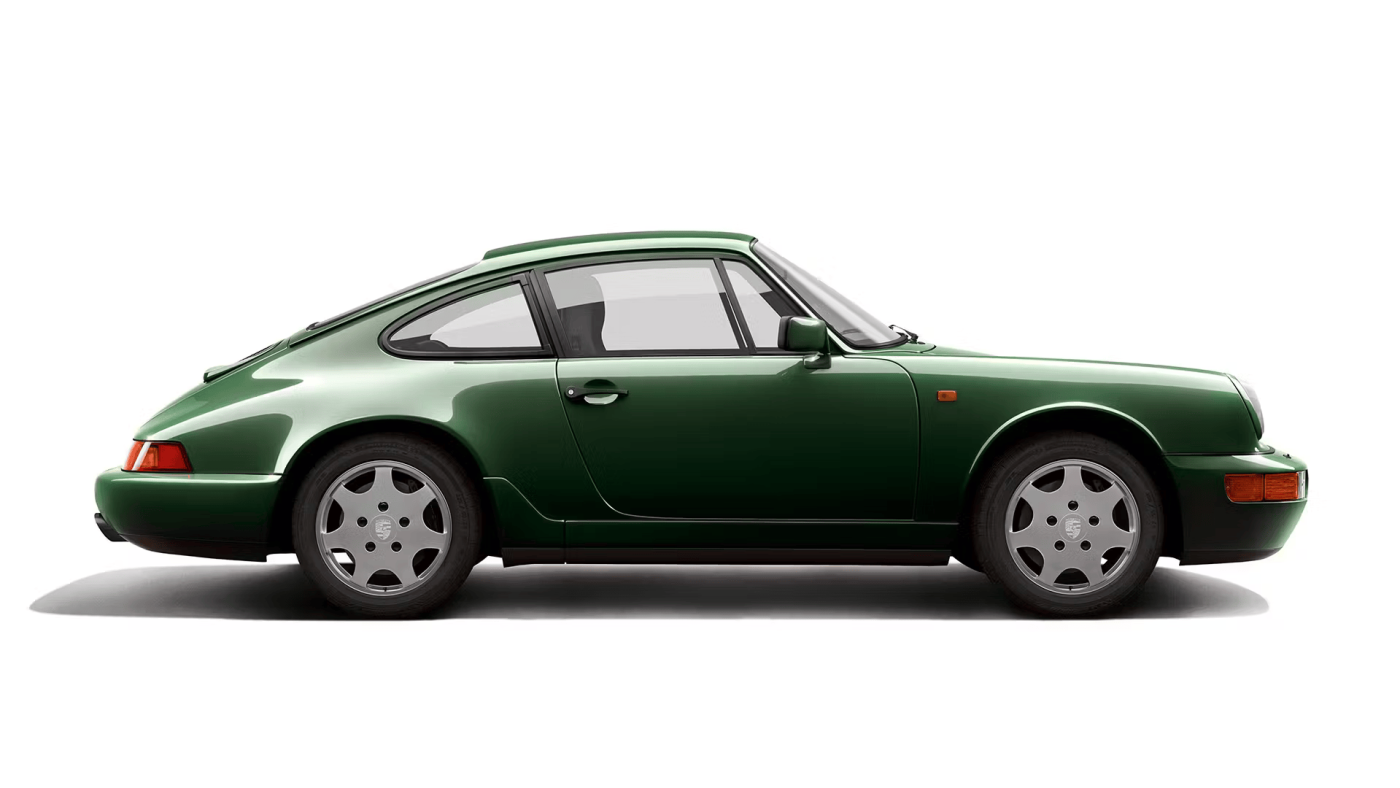
The Type 964 911 first launch with an all wheel drive model. It was a serious investment by Porsche in updating the chassis and tech platform. The 964 Carrera 4 was powered by the M64/01 3.6 liter flat six engine, developing 250 bhp and 229 ft/lbs of torque. The objective of the C4’s all-wheel-drive system was not only to provide improved traction but also better handling, especially in the wet and on slippery surfaces. The Carrera 4 model also launched with a Cabriolet version in 1989 (for 1990 model year). The added weight needed meant that both the Coupe and Cab needed ABS brakes and power steering (a first for a 911). In addition to the Coupe and Cabriolet versions, the 964 Carrera 4 had a Targa body style. Only 1,329 of the C4 Targas were sold.
While it was developed alongside the 964 Carrera 4, Porsche waited a year to release the Carrera 2 as a 1990 model year car. It launched with Coupe, Cabriolet and Targa body styles. The rear-engined, rear wheel drive C2 was 220 lb lighter than its C4 sibling was more fun to drive, was sportier and was considered a true successor to the Carrera 3.2 of 1984. The Coupe was (and still is) the enthusiast sports car driver’s choice, while the Targa and Cabriolet were (and still are) popular with those who want their 911 experience with some fresh air. From the outside the Carrera 2 looks exactly like the Carrera 4 other than the obligatory ‘2’ on engine lid versus a ‘4’ for the Carrera 4.
Starting in January 1990 the Carrera 2 body styles were available with a new Tiptronic (automatic) gearbox with manual override. Several additional model variants of the C2 came over the following years. In 1992 there was the 964 C2 Cabriolet Turbo-Look (often called the C2 WTL Cabrio), which took the body, chassis, braking system and wheels from the 911 Turbo 3.3. The 964 Speedster came along in 1994.
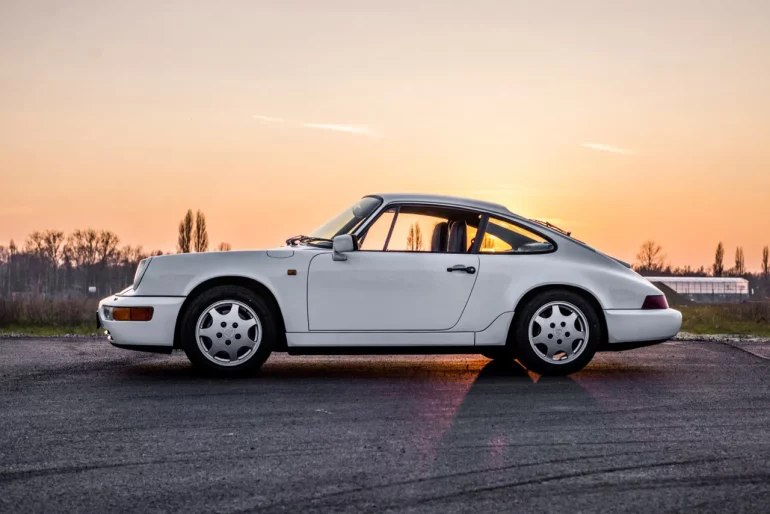
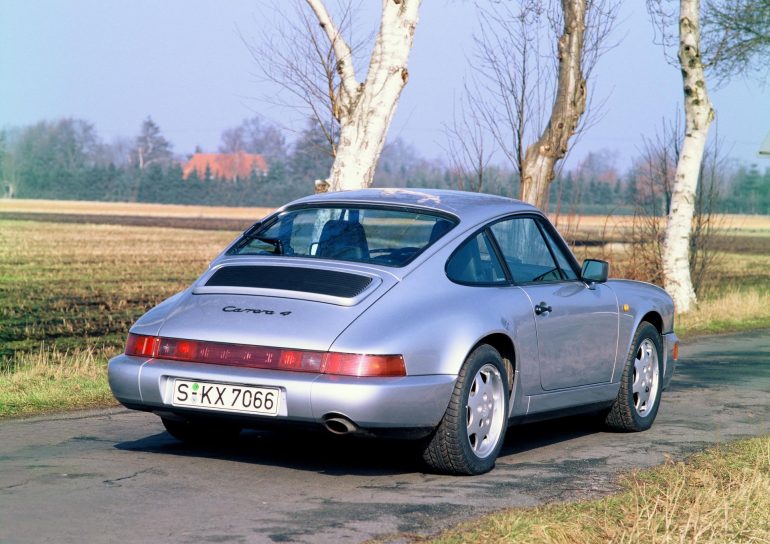
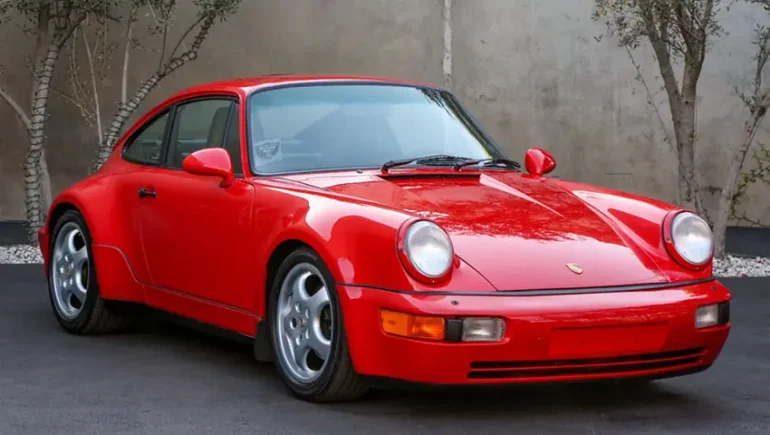
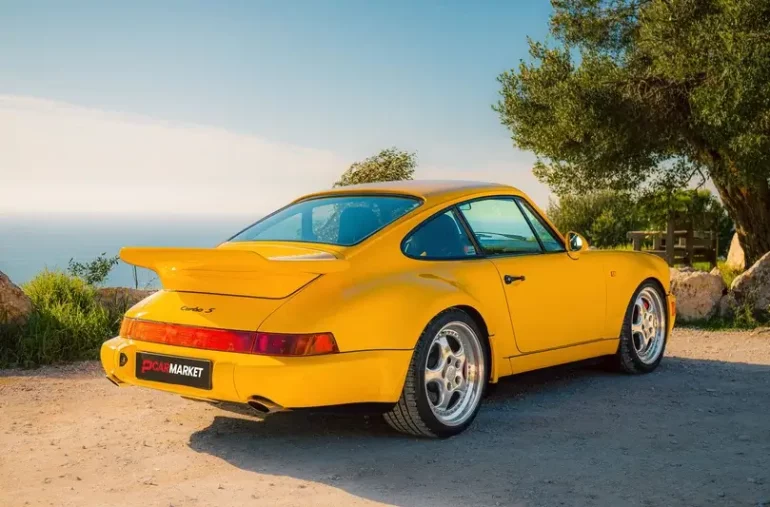

The 964 Turbo was the last of the single turbo rear-wheel drive 911 Turbos and was the successor to the famous 930 Turbo. Porsche engineers had been working on a new turbo motor for the 964 but were not fully ready in time for launch of the 964 Turbo. The result was that the 964 Turbo was initially released with the proven 3.3-litre turbo engine from the 930 Turbo. A number of updates improved the engine and power increased to 320 bhp. The 964 911 Turbo had a wider body with significantly more flared wheel housings.
Several improvements to the 964 Turbo lead to the launch of the very special 964 Turbo S. The idea was to combine the 964 Turbo’s straight-line performance with the Carrera RS’s handling characteristics. The Porsche 964 Turbo S Leichtbau was born for model year 1993. Power was up to 380 horsepower (61 hp above the standard Turbo) thanks to thanks to more aggressive camshafts, new injection valves and more boost pressure. The Turbo ended up 400 pounds lighter.
The second generation of 964 Turbo 3.6 launched as a 1993 model year car. The 3.3 liter turbo engine was replaced by a 3.6 liter turbo engine based on the M64 power unit in the 964 Carrera 2 and Carrera 4. Power was up to 360 bhp @ 5,500 rpm and torque was up to 384 ft/lbs @ 4,200 rpm. Other upgrades included better brakes, lower suspension and 18 inch 3-piece Speedline wheels. At the end of 964 production, the Porsche factory had 93 Turbo chassis left. These were all sent to Porsche Exclusiv and built as special 964 Turbo 3.6 S, offered with normal, or ‘Flachbau’ slant nose front ends.
In hommage to the 1973 911 Carrera RS, Porsche used the same formula to produce a lightweight version of the Carrera 2 from the race-ready Cup car known simply as the Carrera RS. A primary objective for Porsche engineers was making the 964 RS as light as possible and in the end they were able to take out almost 300 pounds of weight. At 2706 pounds the 964 RS was 286 pounds lighter than the standard model. The RS used an upgraded version (M64/03) of the M64 engine used in the 964 Carrera 2 and 4 (M64/01). Power was boosted by 10 horsepower from the new 3.6 liter boxer engine thanks to some magic by Porsche engineers. Power went from 250 hp to 260 hp and torque increased from 229 ft/lbs to 240 ft/lbs. The chassis was stiffened thanks to additional bracing and welding in key areas. The suspension on the Porsche Carrera RS was lowered by 40mm and made considerably stiffer with race-tuned shock absorbers. The 964 Carrera RS was offered in three road legal versions. The first was a base option that offered no luxury at all, the second, a touring model, came with limited extras and the third was the N-GT (near-production GT).
The original 1973 Carrera RS was available in Europe but not in the USA. Porsche decided to build the 1993 Carrera RS both to European spec and a limited number in compliance with US regulations. These US spec cars were assigned the name “RS America”.
Porsche wanted to race an RSR variant in the GT-category and the result was the car you see here, the Porsche 911 Carrera RS 3.8 (964). The RS 3.8 served as the homologation base for the 3.8 RSR for international competition. Many of its features were borrowed from the 964 Carrera Cup cars. There were two versions; the Sport (or Lightweight) weighed about 10 percent less than the Touring version. Only 55 cars were ever made and they were all special ordered from the factory. Power for the RS 3.8 came from a 3.8 liter version of the M64 motor and was good for 300 bhp.
The rarest 964 RS variant was the awesome 964 C4 Lightweight. Known as the 964 Leichtbau it made use of surplus parts from 953 Paris-Dakar project and only 22 were ever made. The idea was to combine the 964 RS body with the more sophisticated all-wheel-drive system from the 959 while lowering weight. The 964 C4 Lightweight was powered by the same 3.6 liter flat six as the normal 964 RS, but was fettled to produce 300 hp.
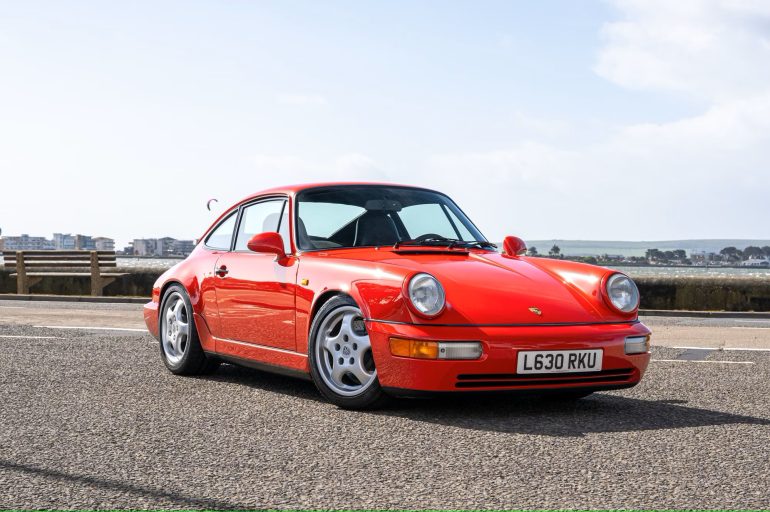
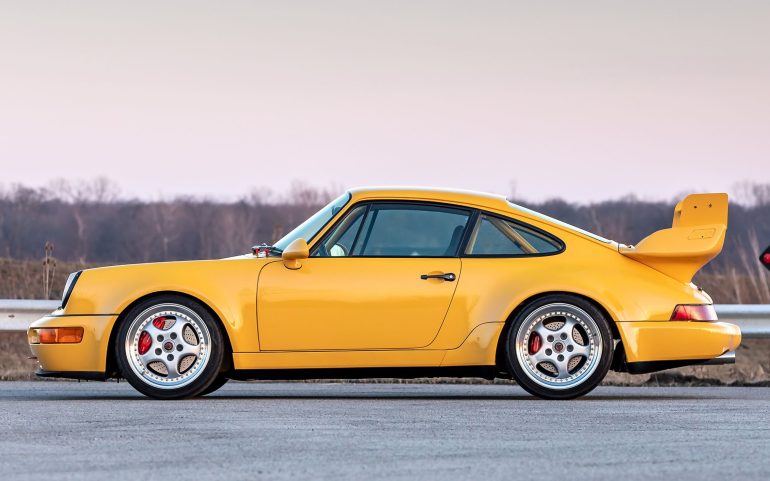
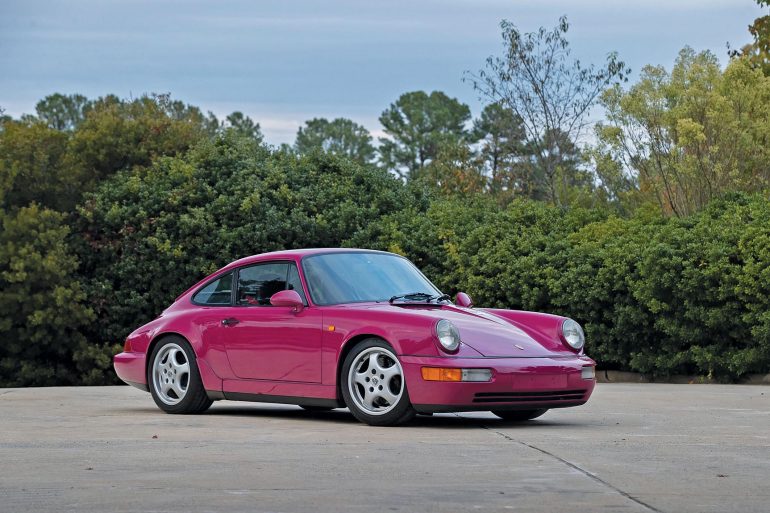
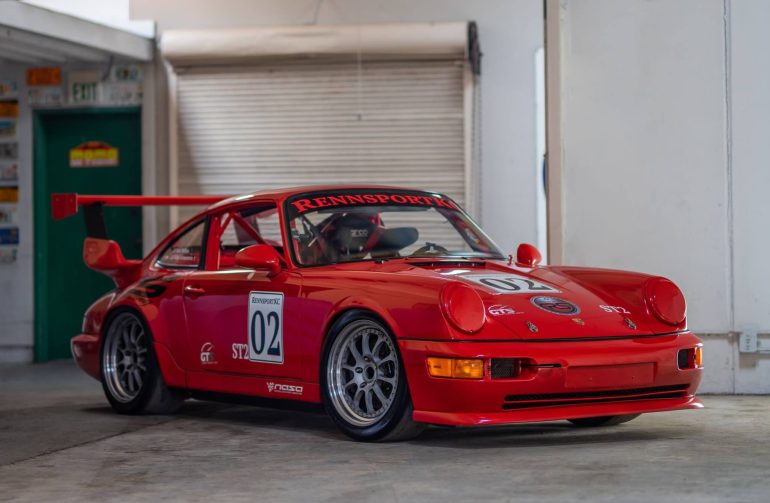

In 1990 Porsche devised a racing series for the 964 Carrera 2 known as the 1990 Pirelli Carrera Cup Competition and later series such as the Trophie Series and the 1993 Supercup. These cars were completely stripped out for series racing by fitted with aluminum shut panels and a roll-bar system. They were fitted with the M64/03 with a bespoke aluminum intake and a G50/10 gearbox, but almost every system in the car was updated for race preparation. Many of these developments were pushed onto the limited Carrera RS in 1992.
In 1990 and 1991 Porsche made a total of 172 Carrera Cup cars. These were updated to M0001 specification in 1992 with a two-year production of 127 cars bringing the four year total to 299 Carrera Cup cars.
The 964 Carrera RSR reflected Porsche’s return to production-based GT racing dominance. The Carrera RSR 3.8 was an all-out racing car and could be delivered to the track in a race-ready, ‘just-add-driver’ form. The engine of this car was further tweaked and fitted with racing cams, the output varying from 325bhp to 375bhp, depending on track requirements.
Based on the only slightly less-potent RS 3.8, the RSR was a full-bore lightweight Turbo-bodied beast aimed at major European GT contests and the North American Supercar series. The rear of the 911 Turbo’s wide body was occupied by a model-specific Type M64/04 3.8-liter air-cooled flat-six, naturally aspirated with 11.4:1 compression, lighter pistons, dual ignition, new intake manifolds with six individual butterflies, dry-sump lubrication, and Bosch electronic fuel injection. Power was fed through a racing clutch to an uprated five-speed manual transaxle with 40 percent limited-slip.

There are three basic engines used in the non-Turbo 964’s. They are the M64/01, M64/02 and M64/03. The 964 engines were the first produced by Porsche which were the same for all markets, worldwide. All three engines were naturally aspirated, air-cooled or oil-cooled, horizontally opposed (flat), dry-sump lubrication and obviously rear-mounted and all three had a displacement of 3600cc.
The M64 engine is oil and air cooled and, as a consequence, has a lot of oil (11.5 liters) when compared to a more usual water cooled engine. Air is blown over the engine from the main crankshaft driven fan and is also drawn over the engine as the vehicle moves forward. Oil is routed throughpipes along the right hand sill to the front mounted oil cooler which is called into play once the oil thermostat (in front of the right rear wheel) opens. The engine uses a dry sump lubrication system which avoids oil starvation issues in extreme G-force conditions. Using 2 valves per cylinder with a single chain driven overhead camshaft per cylinder bank operating both inlet and exhaust valves via rocker arms, the engine design is heavily based on that of the GT1 racer.
The M64/01 was fitted to the standard Carrera 2 and Carrera 4 models with manual transmissions. The M64/02 was fitted to the Tiptronic-equipped Carrera 2. The M64/01 and M64/02 had 100 mm Bore and 76.4mm Stroke, with a compression ratio of 11.0:1. The M64/03 was fitted to the Carrera RS. It had a remapped engine program and slightly higher compression ratio of 11.3:1 when compared to the M64/01 and M64/02. The result was a bit more horsepower at 260 hp at 6,100 rpm and torque of 229 ft/lbs at 4,800 rpm.
There was also a super rare M64/04 engine used in the Carrera RS 3.8. The engine was known as M64/04. While retaining the same 76.4 mm stroke of the 3.6 liter, the bore was stretched to 102mm, increasing the engine capacity to 3746cc. It also had larger valves, individual throttles and a 11.6:1 compression ratio. In the RS 3.8, the engine produced 300 bhp @ 6100 rpm and torque of 265 ft/lbs @ 4800 rpm. It was further tweaked for the RSR with racing cams and the output varied from 325bhp to 375bhp, depending on the restrictors fitted according to the different class regulations applicable.
When the 964 Turbo was unveiled in 1990, Porsche reused the 3.3 liter engine from the Type 930 because it did not have the necessary time to develop a turbo version of the 3.6 liter M64 engine before it released the Turbo variant. A few revisions were made to increase power, but it was basically the same basic engine. Displacement was 3,299 cc.
Power was 320 bhp at 5,750 rpm and torque was 362 ft/lbs at 4,800 rpm. The turbo had less turbo lag than the 930 engine and was different enough that it was designated with its own M30/69 code. A more powerful version of the turbo engine was used in the very limited edition 964 Turbo S 3.3. Power was up from 320 hp to 381 bhp at 6000 rpm with torque of 362 ft/lbs at 4800 rpm.
The 3.6L M64 turbo was finally made available in 1993 and was known as the M64/50 engine. It was a marked improvement over the old M30/69 engine and powered all Turbo 964 models after 1993. The engine had a 3,600 cc (220 cu in) displacement with a 7.5:1 compression ratio. This fine-tuned version of the M64 engine produced an impressive 360 bhp at 5,500 rpm and 384 ft/lbs at 4,200 rpm. A more powerful version of the M30/69 engine was used in the 964 Turbo S 3.6. Power was up 20 hp to 380 hp.
We dig into some of the data surrounding the third generation Porsche 911, including production numbers, specifications, chassis numbers, sales brochures, equipment codes, maintenance schedules, common problems, colors and much more.
The Porsche 911 (964 generation) was primarily designed under the direction of Harm Lagaaij and Benjamin Dimson, building upon the foundation created by Ferdinand Alexander “Butzi” Porsche, who designed the original 911. Dimson, who succeeded Anatole “Tony” Lapine as Porsche’s head of styling in the 1980s, led the 964’s exterior design, while Lagaaij — who later became Porsche’s Director of Design — contributed to refining its aerodynamics and proportions.
The 964 was one of the most technically advanced redesigns in the 911’s history, sharing only about 15% of its components with the outgoing G-Series. It retained the classic 911 silhouette but featured a smoother, more aerodynamic body with integrated bumpers, a retractable rear spoiler, and cleaner lines that modernized the car while respecting its heritage. Beneath the familiar shape, the 964 introduced radical engineering updates: all-wheel drive in the Carrera 4, a completely new suspension with coil springs and shocks instead of torsion bars, ABS brakes, power steering, and improved aerodynamics.
In essence, the 964 was a bridge between the classic and modern eras of Porsche design — visually timeless thanks to Dimson’s subtle evolution of Butzi’s shape, and technically groundbreaking thanks to Lagaaij and Porsche’s engineering team. It was the car that brought the 911 into the 1990s while proving that Porsche could evolve without losing the essence of what made the 911 iconic.
The Porsche 911 (964 generation) was produced from 1989 to 1994, serving as the third generation of the 911 and marking the bridge between the classic air-cooled era and the modern age. It debuted in 1989 with the Carrera 4 (C4) — the first 911 to feature all-wheel drive, derived from Porsche’s 959 supercar technology — followed shortly by the rear-wheel-drive Carrera 2 (C2) in 1990. Over its production run, the lineup expanded to include Coupé, Targa, and Cabriolet body styles, as well as high-performance variants like the Turbo (1990–1994), RS (1992), and Speedster (1993–1994).
By the time production ended in 1994, the 964 had introduced over 85% new components compared to the outgoing G-Series 911, including a new suspension, ABS brakes, power steering, and a modernized body with integrated bumpers and a retractable rear spoiler. It was succeeded in 1995 by the 993 generation, the final air-cooled 911.
The Porsche 911 (964 generation) was one of the most technically innovative and transformative models in the 911’s history. It was almost entirely new, with Porsche claiming that 85% of its components were redesigned. The 964 introduced all-wheel drive for the first time in a production 911 (in the Carrera 4), borrowing technology from the legendary 959 supercar. It also replaced the old torsion-bar suspension with modern coil springs and shocks, dramatically improving ride comfort and handling precision. Other innovations included power steering, ABS brakes, standard airbags, modern climate control, and an aerodynamically integrated body with flush bumpers and a retractable rear spoiler that automatically adjusted at speed — subtle but revolutionary changes that brought the 911 into the modern era.
What made the 964 special is how it managed to combine this leap in technology with the traditional 911 character. It retained the air-cooled flat-six engine, now enlarged to 3.6 liters and producing up to 250 hp, offering both refinement and classic Porsche sound. The all-wheel-drive Carrera 4 proved that the 911’s tail-happy handling could be tamed without dulling its spirit, while the rear-wheel-drive Carrera 2 preserved the pure, analog driving experience enthusiasts loved. The 964 also spawned some of the most iconic derivatives of the era, including the 911 Turbo, Carrera RS, and Speedster, all of which showcased Porsche’s ability to balance innovation with heritage. In short, the 964 was the first truly modern 911 — a car that kept its soul intact while embracing technology, making it the model that secured the 911’s future in a rapidly changing automotive world.
The Porsche 911 (964 generation) was impressively fast for its time, combining classic 911 character with modern performance. The standard Carrera 2 and Carrera 4 models used a new 3.6-liter air-cooled flat-six engine producing 247 hp (250 PS) and 228 lb-ft of torque, allowing them to sprint from 0–60 mph in about 5.5 seconds and reach a top speed of roughly 162 mph (260 km/h) — putting them firmly in supercar territory for the early 1990s. The manual Carrera 2 was slightly quicker than the all-wheel-drive Carrera 4, thanks to its lighter weight and rear-drive layout.
The performance climbed even higher with the 964 Turbo, introduced in 1990. The early 3.3-liter Turbo (320 hp) could hit 0–60 mph in 4.8 seconds and top out around 168 mph (270 km/h), while the later 1993 Turbo 3.6 raised power to 355 hp and pushed top speed to nearly 175 mph (282 km/h) — making it one of the fastest production cars of its era. Meanwhile, the lightweight Carrera RS of 1992, stripped for performance and featuring a more responsive version of the 3.6-liter engine, could reach 0–60 mph in around 5 seconds flat, delivering an unmatched connection between driver and machine.
Beyond straight-line speed, what really made the 964 fast was its real-world capability — with improved aerodynamics, a modern suspension, and, in the case of the Carrera 4, all-wheel drive that provided extraordinary traction and stability. The 964 wasn’t just about raw acceleration; it was a car that could cover ground astonishingly quickly on any road, in any weather, and it set the dynamic benchmark for every 911 that followed.
When it comes to the Porsche964, the “best” variant depends on what you’re looking for — driving purity, everyday usability, or collector appeal — but certain years and models clearly stand out. For most enthusiasts, the 1992–1994 Carrera 2 (C2) is the sweet spot. These later cars benefitted from refined engine electronics, improved build quality, and fixes to early oil leaks and dual-mass flywheel issues that plagued the first 1989–1991 models. The Carrera 2 offers the pure rear-wheel-drive dynamics many enthusiasts prefer, with fewer maintenance complexities than the all-wheel-drive Carrera 4. It’s also lighter and feels more agile, making it the best representation of a “classic modern” 911.
If performance and rarity are the goal, the 1993 Turbo 3.6 is the crown jewel of the 964 range. With 355 hp, stunning acceleration, and limited production numbers, it’s now a blue-chip collector’s car — but values are very high. The 1992 Carrera RS is another top-tier choice for purists, offering a lighter, sharper, and more track-focused driving experience. For those seeking a mix of style and collectibility, the 1993–1994 Speedster delivers open-top thrills in a minimalist package, though it’s rare and expensive.
As for models to approach with caution, the early 1989–1991 Carrera 4s can be less desirable due to the complex early AWD system, which can be costly to maintain, and early build issues like leaky cylinder head gaskets and dual-mass flywheel failures. These issues were largely resolved by 1992, making later cars more reliable and easier to live with. In short, the 1992–1994 Carrera 2 or Turbo 3.6 are the best-balanced and most desirable variants, while early-production cars require careful inspection and solid maintenance history to be truly worthwhile.
The market for a used Porsche 911 (964 generation) (1989–1994) shows a wide range of values depending on model variant, condition, mileage and originality. According to market-benchmark data:
A typical Carrera 2 from around 1990 in “good” condition is valued at roughly US $90,000. For example, standard Carrera 4 coupes from 1989-94 show market benchmarks around US $87,000.
More rare or performance-models command significantly higher prices. For instance, the coveted Carrera RS (964) variant averages at about £187,617 (British pounds) in average condition — which emphasizes how much premium is attached to rarity and performance.
In short: if you’re looking at a solid, non-exotic 964 Carrera in good shape, plan on something in the US $75,000-100,000 range. If it’s a special edition, low-mileage or performance model (RS, Turbo, Speedster), values rise sharply — easily into the six-figures. Naturally, condition, originality, maintenance history and matching numbers will make a big difference.
Yes — the Porsche 964 underwent several key updates during its relatively short production run, reflecting how Porsche steadily refined this new, more modern platform. The 964 was already a massive leap forward from the G-Series it replaced, but the continuous improvements made it progressively more reliable, better handling, and more desirable.
When the 964 debuted in 1989, it launched as the Carrera 4 (C4) — the first production 911 with all-wheel drive, derived from the 959 supercar’s advanced AWD system. A year later, in 1990, Porsche introduced the Carrera 2 (C2), a lighter, rear-wheel-drive version that many enthusiasts preferred for its purer dynamics. Around this time, Porsche also made running changes to fix early reliability issues, such as cylinder head sealing leaks and dual-mass flywheel failures. In 1990, the 911 Turbo returned, initially with a 3.3-liter engine carried over from the previous generation but heavily revised for smoother power delivery and better reliability. Then in 1992, the Turbo 3.6 arrived — a major update with a new 355-hp engine that transformed performance and cemented the 964 Turbo’s legendary status.
Later years brought even more refinement and special editions. In 1992, Porsche introduced the Carrera RS, a lightweight, stripped-down performance version for purists, and the America Roadster, a limited-production wide-body cabriolet. By 1993–1994, the final years of production, Porsche added the Speedster (with its distinctive low windshield and minimalist interior) and further refined build quality, electronics, and reliability. By the time production ended in 1994, the 964 had evolved from an ambitious redesign with teething issues into a mature, high-performance, and reliable 911, laying the foundation for the even more advanced 993 generation that followed.
Join Our Porsche Community
Sign up for our weekly Porsche newsletter. The latest Porsche news, rumors, reviews and more delivered to your inbox. Cool Porsche stuff perfect for the flat-six obsessed.